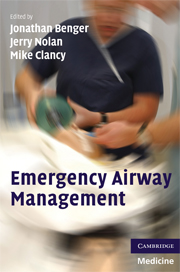Book contents
- Frontmatter
- Contents
- List of contributors
- Foreword
- List of abbreviations
- 1 Introduction and overview
- 2 Delivery of oxygen
- 3 Airway assessment
- 4 Basic airway management techniques
- 5 Indications for intubation
- 6 Preparation for rapid sequence induction and tracheal intubation
- 7 Rapid sequence induction and tracheal intubation
- 8 Pharmacology of emergency airway drugs
- 9 Difficult and failed airway
- 10 Post-intubation management and preparation for transfer
- 11 Emergency airway management in special circumstances
- 12 Non-invasive ventilatory support
- 13 The interface between departments and hospitals
- 14 Audit and skills maintenance
- Appendix: Emergency airway algorithms
- Index
- References
8 - Pharmacology of emergency airway drugs
Published online by Cambridge University Press: 22 August 2009
- Frontmatter
- Contents
- List of contributors
- Foreword
- List of abbreviations
- 1 Introduction and overview
- 2 Delivery of oxygen
- 3 Airway assessment
- 4 Basic airway management techniques
- 5 Indications for intubation
- 6 Preparation for rapid sequence induction and tracheal intubation
- 7 Rapid sequence induction and tracheal intubation
- 8 Pharmacology of emergency airway drugs
- 9 Difficult and failed airway
- 10 Post-intubation management and preparation for transfer
- 11 Emergency airway management in special circumstances
- 12 Non-invasive ventilatory support
- 13 The interface between departments and hospitals
- 14 Audit and skills maintenance
- Appendix: Emergency airway algorithms
- Index
- References
Summary
Objectives
The objectives of this chapter are to:
be familiar with the choice of induction, analgesic and neuromuscular blocking drugs
understand the advantages and disadvantages of drugs used in emergency airway management
understand the basic pharmacology of these drugs
be aware of the possible complications caused by these drugs.
Introduction
The term ‘triad of anaesthesia’ is used to describe the components of a balanced anaesthetic:
hypnosis
analgesia
muscle relaxation.
The pharmacology of drugs used commonly in emergency airway management will be considered under these three headings.
In unmodified rapid sequence induction (RSI) an analgesic is omitted and the patient is given a pre-calculated dose of induction drug and neuromuscular blocker only. The rationale behind this is that, should intubation fail, the patient will recover from anaesthesia and paralysis quickly, returning to spontaneous ventilation. Opioids, particularly in high doses, will increase the time to spontaneous ventilation. Some patients may have received analgesia before the induction of anaesthesia (e.g. for pain relief in trauma), and under some circumstances it is appropriate to consider modifying an RSI to include a carefully selected dose of opioid given before the induction drug (e.g. RSI in the presence of raised intracranial pressure: see Trauma and raised intracranial pressure in Chapter 11). Opioids are also useful after intubation, when they may be used in combination with a hypnotic to maintain anaesthesia and reduce sympathetic stimulation.
- Type
- Chapter
- Information
- Emergency Airway Management , pp. 67 - 80Publisher: Cambridge University PressPrint publication year: 2008

